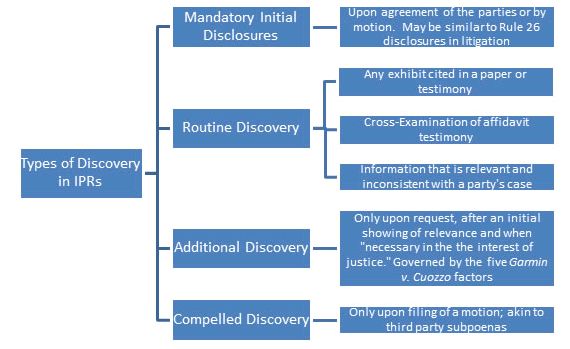Inter partes review (IPR) before the Patent Trial and
Appeal Board (PTAB) became available on September 16, 2012 as a
post-grant review procedure to challenge the patentability of
issued claims based on prior art patents and publications. To help
navigate the uncharted waters of this procedure, each edition
of IP Buzz - Post Grant Practice will include an
installment of our new IPR Spotlight Series, where we will
feature a specific event on the
IPR timeline, from filing the petition for IPR through oral
hearing and final written decision. We will present an overview of
the featured filing or procedure, along with practice tips and
strategy informed by recent PTAB decisions, statistics, and
practical experience. In our fifth IPR Spotlight installment, we
focus on navigating IPR discovery.
Part 5: Navigating IPR Discovery
The America Invents Act ("AIA") offers very limited
discovery in IPR proceedings, including "the deposition of
witnesses submitting affidavits or declarations" and
"what is otherwise necessary in the interest of
justice."1 The PTAB has interpreted these
provisions to cover three categories of discovery: (1) mandatory
initial disclosures;2 (2) routine discovery;3
and (3) additional discovery.4 In addition, a party may
move to compel discovery from third parties.5
On September 30, 2014, the PTAB issued guidelines on routine and
additional discovery, in
an article by Administrative Patent Judges Jacqueline Bonilla and
Sheridan Snedden. The article explains the difference between
routine and additional discovery, and delineates the PTAB's
considerations when deciding whether to grant motions for
additional discovery.
This article sets out the three categories of discovery, plus
third party discovery in IPR, along with the PTAB's recent
guidance on routine and additional discovery. A brief
overview of the types of possible discovery is shown in Figure 1
below.

Figure 1: The Types of Limited Discovery Available
in IPR Proceedings
1. Mandatory Initial Disclosures
The term "mandatory initial disclosure" is somewhat
misleading because this type of disclosure is not mandatory at all;
in fact, the parties must agree on mandatory discovery and file a
notice with the PTAB indicating which form of initial discovery the
parties have agreed upon.6 This notice must be filed
before the deadline for the patent owner to file its preliminary
response in order for initial disclosures to be used at all.
7Once trial is instituted, the parties may then
automatically take discovery of information identified in the
initial disclosures.8 As a result, initial disclosures
are the least used of the three categories of discovery.
Initial disclosures come in two forms:
1) Both parties disclose identities of individuals likely to have discoverable information and provide documents they may use to support defenses; and
2) If the IPR petition raises obviousness, the petitioner must make disclosures regarding objective evidence.9
If the parties fail to reach an agreement, the parties "may
seek the mandatory discovery ... by motion."10
Mandatory initial disclosures are similar in scope to initial Rule
26 disclosure in a civil litigation.11 The PTAB has an
upcoming article that will provide additional guidance on mandatory
initial disclosures.
2. Routine Discovery
Routine discovery is automatic and does not require a motion or
requests for discovery.12 Instead, the producing party
has the obligation to provide the material on its own.13
Routine discovery includes:
1) Any exhibit cited in a paper or in testimony in the case: A party must serve these exhibits at the same time it serves the paper or testimony citing to them. This category is limited to the evidence actually cited, not materials that the party or witness relies upon when preparing the paper or testimony.14
2) Cross examination of affidavit testimony: A party relying on a witness's testimony by declaration or affidavit must make that witness available for cross-examination. The burden and expense of producing a witness for cross-examination falls on the party presenting the witness. The rules allow very long deposition time limits: seven hours for cross-examination, four hours for redirect examination, and two hours for re-cross examination.15
3) Information that is relevant and inconsistent with a party's case, which must be served concurrently with the filing of documents or things that contain the inconsistency.16 A party typically seeks inconsistent information via document request, although interrogatories and requests for admission may also be used.17 This category excludes privileged materials, and is "not broadly directed to any subject area in general within which the requesting party hopes to discovery such inconsistent information."18
3. Additional Discovery
Parties may also agree to additional discovery, beyond routine
discovery.19 If the parties cannot reach agreement, then
a party must request additional discovery.20 However,
the PTAB grants very limited discovery when it is granted at all. A
preliminary showing of relevance is necessary.21 In
order to determine whether additional discovery in an IPR
proceeding is "necessary in the interest of justice," the
PTAB uses a five-factor test set forth in the first IPR, Garmin
International Inc. et al. v. Cuozzo Speed Technologies
LLC:22
1) More Than a Possibility and Mere Allegation. The mere possibility of finding something useful, and mere allegation that something useful will be found, are insufficient to demonstrate that the requested discovery is necessary in the interest of justice. The party requesting discovery should already be in possession of evidence tending to show beyond speculation that in fact something useful will be uncovered.
2) Litigation Positions and Underlying Basis. Asking for the other party's litigation positions and the underlying basis for those positions is not necessarily in the interest of justice.
3) Ability to Generate Equivalent Information by Other Means. Information a party can reasonably figure out, generate, obtain, or assemble without a discovery request would not be in the interest of justice.
4) Easily Understandable Instructions. The requests themselves should be easily understandable. For example, ten pages of complex instructions is prima facie unclear.
5) Requests Not Overly Burdensome To Answer. The Board considers financial burden, burden on human resources, and burden on meeting the time schedule of the review. Requests should be sensible and responsibly tailored according to a genuine need.
Under this standard, the PTAB has granted only 29% of motions for
additional discovery. The PTAB's current policy on
additional discovery has been a primary focus of the USPTO's
"Request for Comments on Trial Proceedings Under
the America Invents Act Before the Patent Trial and Apply
Board." Recently, the Intellectual Property Owners
Association ("IPO") sent comments to the USPTO in
response.
According to IPO, denials of motions for discovery have largely
focused on Factors 1, 3, and 5, which are accordingly IPO's
targets for change:
- Factor 1: Under Factor 1, unless a co-pending
litigation is fairly far along, the requesting party will have
difficulty demonstrating beyond mere possibility that responsive
information exists. For example, under Schott Gemtron Corp. v. SSW
Holding Co., Inc.,23 the PTAB denied the motion for
additional discovery regarding commercial success, finding that the
request did not provide a threshold amount of evidence of sales
allegedly amounting to commercial success, or alleged nexus between
the claimed invention and commercial success.
IPO has noted the unfairness in requiring a patent owner to prove the existence of commercial success and provide a likelihood of nexus before being able to discovery the evidence necessary to make out such a case. This critique applies to other objective indicia of nonobviousness as well, such as unexpected results, copying, and licensing. Accordingly, IPO believes that PTAB should relax the first factor to "a reasonable basis that the non-moving party has evidence relevant to objective indicia of non-obviousness" instead of the current "more than a mere possibility" standard.
- Factor 3: Under Factor 3, the PTAB denies
discovery where a patent owner fails to demonstrate why the
requested information could not be figured out or assembled from
internal or publicly available sources. For example, in Corning
Inc. v. DSK IP Assets B.V.,24 the PTAB denied a request
for samples because the requesting party failed to show that it
could not get information through documents otherwise
produced.
- Factor 5: Under Factor 5, the patent owner
must show that the requests are very narrowly tailored and will not
impose a significant burden on the producing party. For example, in
Microsoft Corp. v. Proxyconn, Inc.,25 the PTAB denied
additional discovery relevant to commercial success, noting that
among other things, certain requests were not time-limited, and
were imprecise, unfocused, and unduly burdensome.
Accordingly to IPO, the PTAB could use the fifth factor to ensure any requests are limited – by documents already in existence, shortened time windows, limited number of products, etc. This would strike a balance between the moving party obtaining necessary documents to determine whether objective indicia of non-obviousness are present while still protecting the non-moving party from overly burdensome requests.
Under the current standard, parties seeking additional discovery
should draft narrow and clearly stated requests. In addition, the
party must demonstrate that the information sought exists, and
materially affects the party's position in the IPR proceeding.
For example, in Corning Inc. v. DSM IP assets B.V., the PTAB
granted a request for laboratory notebooks, where the details of
procedures were per se useful when a petitioner cited expert
testimony that relied upon those details to demonstrate
unpatentability.
4. Compelled Discovery
Under 37 C.F.R. § 42.52, a party may also file a motion to
obtain "compelled discovery," akin to a subpoena,
consisting of documents and testimony from third parties. The
requesting party must first make a motion for authorization to the
PTAB and identify the witness and any request documents. If a
motion to compel is granted, the testimony may be (1) ex parte
subject to cross-examination or (2) inter
partes.26
Keeping Discovery Limited
The PTAB has emphasized that AIA trials were created as "a cost-effective alternative to
litigation," and therefore public policy dictates limiting
discovery in these proceedings. The PTAB article noted the
benefits of "lowering costs, minimizing complexity, and
shortening periods required for dispute resolution," along
with meeting the one-year statutory deadline for completing AIA
Trials. Unlike district court patent litigation, parties in
IPR proceedings must use requests for additional discovery
sparingly, and narrowly tailor any requests that are made.
For defendants accused of patent infringement in district court
litigation, participating only in limited discovery that focuses
primarily on prior art documents and declarants in support of a
patent position is a great advantage over the broad and expensive
discovery in district court litigation, which almost always proves
more burdensome on the defendant than the patent owner
plaintiff. Venable will continue to monitor potential change
in response to the USPTO's request for comments, as well as
additional guidance from the PTAB.
Footnotes
1 35 U.S.C. § 316(a)(5).
2 37 C.F.R. § 42.51(a).
3 37 C.F.R. § 42.51(b)(1).
4 37 C.F.R. § 42.51(b)(2).
5 37 C.F.R. § 42.52.
6 37 C.F.R. § 42.51(a)(1).
7 37 C.F.R. § 42.51(a)(1)(i).
8 37 C.F.R. § 42.51(a)(1)(ii).
9 PTO Trial Practice Guide at 27-28, 77 Fed. Reg. 48761-62.
10 37 C.F.R. § 42.51(a)(2).
11 PTO Trial Practice Guide at 27-28, 77 Fed. Reg. 48761-62.
12 See BlackBerry Corp. et al. v. Wi-Lan USA Inc., IPR2013-00126,
Paper 15 at 2 (Aug. 19, 2013).
13 37 C.F.R. § 42.51(b)(1).
14 See Blackberry Corp. et al. v. Wi-Lan USA Inc., IPR2013-00126,
Paper 15 at 2 (Aug. 19, 2013).
15 37 C.F.R. § 42.53(c)(2).
16 37 C.F.R. § 42.51(b)(1)(iii).
17 Id.
18 See Garmin Int'l Inc. et al. v. Cuozzo Speed Techs. LLC,
IPR2012-00001, Paper 26 at 4 (March 5, 2013).
19 37 C.F.R. § 42.51(b)(2)(i).
20 Id.
21 See, e.g., Square Inc. v. REM Holdings 3 LLC, IPR2014-00312,
Paper 23 at 4-5 (Sept. 15, 2014).
22 IPR2012-00001, Paper 20 at 2-3 (Feb. 14, 2013).
23 IPR2013-00358, Paper 43 (Feb. 14, 2014).
24 IPR2013-00043, Paper 27 (June 21, 2013).
25 IPR2012-00026, Paper 32 (March 8, 2013).
26 PTO Trial Practice Guide, 77 Fed. Reg. 48671.
The content of this article is intended to provide a general guide to the subject matter. Specialist advice should be sought about your specific circumstances.
[View Source]




